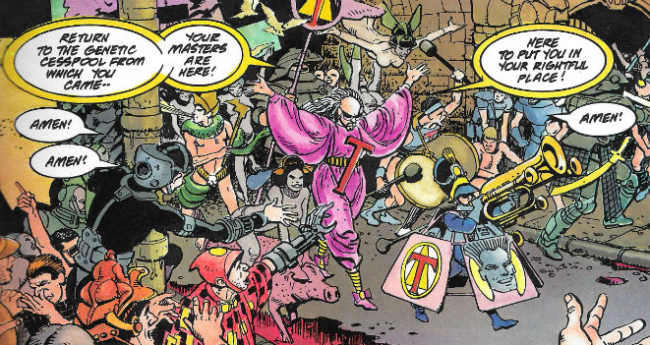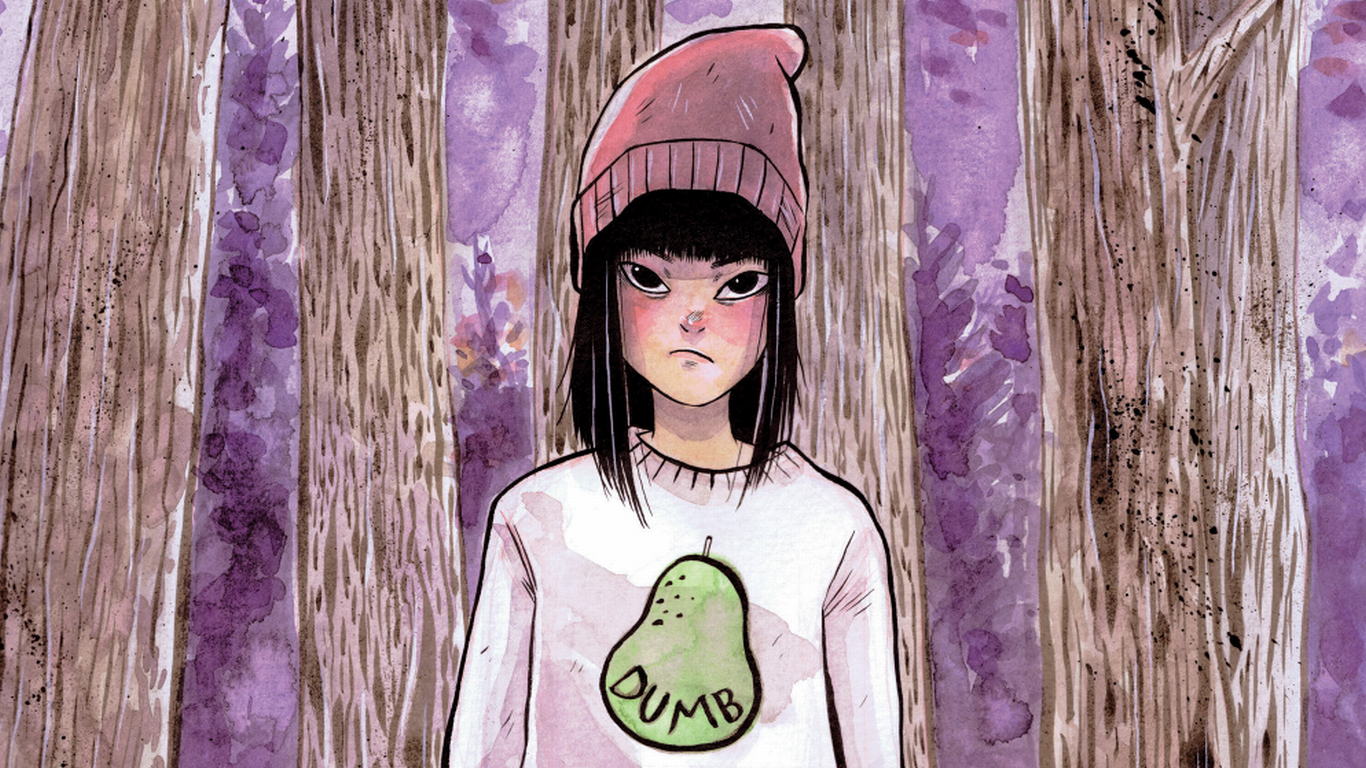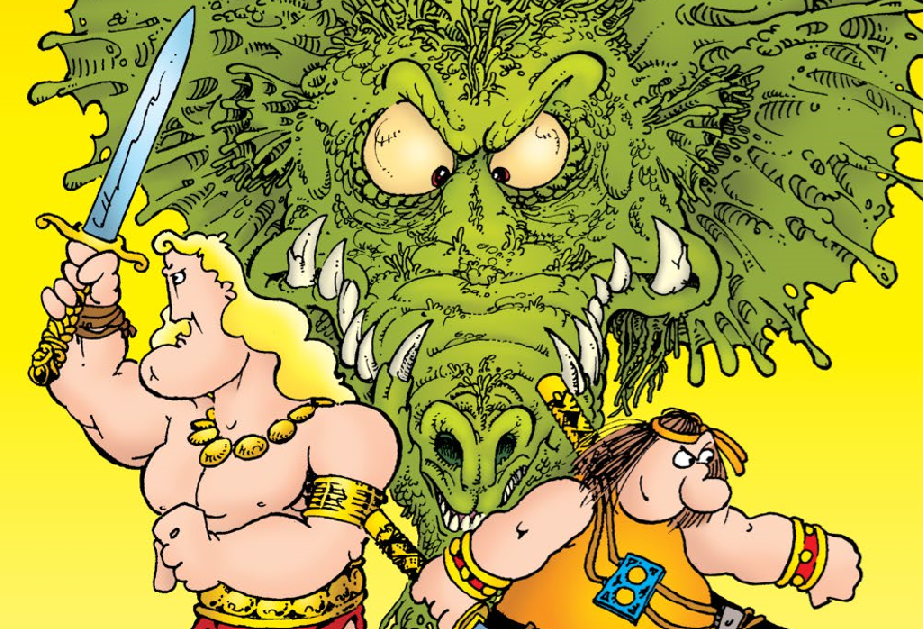The opening scene: commandos in a South American jungle eye a compound defended by a confederation of sentient machines and disenfranchised animal/human hybrids. A negotiation fumbles, the simian rebel leader is beheaded, and the cowardly executioner is canonized. So goes the future envisioned in Twilight, riddled with false idols and an undying quest to quench man’s thirst for greatness.
The review in the introductory pages of Twilight describes it as “one of the highlights of DC’s post-WATCHMEN pre-Vertigo era,” a loaded phrase suggesting the familiar buzzwords: grittiness, ‘realism,’ and post-modern critiques of a younger, more naïve day. Twilight is a paperback reissuing of the original, 3-issue miniseries from the 90s, which reimagined forgotten sci-fi derring-doers from DC’s Golden/Silver Age. Given the period’s inclinations, you’d think you know what to expect, something that gives sci-fi comics the same treatment Watchmen did for superhero books, but you have no idea.
What Twilight does to the concept of a Golden Age of science fiction comics is dead fascinating, pessimistic to the point of nausea, but encapsulating all that gloriously epic, frontier scale inherent in the genre. Predictably, it strips that era’s aesthetic of all its vacuum-sealed goodness, letting in dirt, semen, and human ugliness by the avalanche. But it’s worth stating now that even as a ruthless critique on those one-dimensional, morally absolutist stories, it’s undoubtedly a love-letter too; you simply can’t write that level of depravity and operatic drama without having been ignited by the originals.
Twilight magnifies and examines the Golden Age’s process of mythmaking; in its time, writers wanted an absolute icon, an immaculate figurehead rather than nuanced protagonists, and the prime players of Twilight are doing just that—making immortal edifices either of themselves or of their work.
The main characters retain their gee-golly, acrobatic names from their heyday: Rick Purvis is a sports star, sex symbol, and political hero, kind of like an unlikable Tony Stark, except with none of the talent. Karel Sorensen, originally the ‘token girl’, is reincarnated as a ruthless journalist who wields her sex appeal like a scalpel—in the latter acts of the book, Karel ascends to the goddesshead of the human colonies due to a freak accident resulting in man’s immortality, and cultivates a cult of chastity in her honor guard, and an aura of motherhood towards her adherents. Our narrator, the suave Homer Glint, is a yellow journalist of epic proportions, responsible for spinning this alternate history’s most heinous figures as messiahs, and authoring their associated decrees and holy scriptures even as he publicly mocks their amorality.
Hilariously enough, Glint embodies the sickening power of the pen, especially in the hands of pulp fiction writers and political spin-doctors, which are basically equated here. There are literally no heroes in Twilight, only shadows cast by Glint’s art, shadows which stand foremost in the minds of the masses and commandeer their most base sensibilities.
The book takes for its villain a former futuristic everyman, Tommy Tomorrow, and brilliantly re-mythologizes him as a ruthless egomaniac with a rampaging xenophobia stemming from his orphanage, and doubtful origins. In a future where man has bred new sentience in the form of intelligent robots and human/animal hybrids, and dabbled in lab-grown humans in times of sterility, there’s a backlash against these futuristic minorities and a renewed interest in purity of heritage. In his conquest of the known universe and everything therein, purity is his slogan, and neo-Nazi leather is his motif.
Social demarcation is the prevailing backdrop to man’s futuristic civilization, which is fitting in a book about hubris and constructed deities/heroes. Essentially, the aforementioned characters are no different from the ignorant masses in the background—all strive to separate themselves from the unremarkable mold, all of humanity forms a single deranged arrow of desire pointing towards the stars, and to no reasonable or visible goal in mind. That is what the romanticism of space travel is reduced to: one species’ mindless bid for glory.
The latter half of the book’s conflict centers on the power struggle between Karel’s cult of immortality and grandeur, and Tommy Tomorrow’s tribe of ultraviolence and impotent rage, a struggle which puts conservative conceptions of gender at the heart of Twilight: the human civilization is caught between these two poles, of the hyper-sexualized woman and the hyper-potent man, and the conclusion cuts brilliantly to the heart and psychology of that tension.
And whether the story demands comically sapphire-eyed Saxons, multicultural backwater slum-planets, masses of variegated rabble, all clamoring amongst themselves for genetic status, Jose Luis Garcia-Lopez’s art is up to the task. All of the book’s extremisms are vividly rendered in bold colors and detail—the alley slums bear Mesoamerican-motifed advertisements, and the characters evolve visually through the different stages of their respective legends. The overall style bears the 90s fascination with panoramic detail as opposed to the contemporary cleanliness (almost sterility) of design, but I leave with the feeling that such a sordid dystopia couldn’t be so faithfully represented in any other style.
Even though Twilight basically drags Golden Age sensibilities through the mud and sand, it also points out the one aspect in which the Golden Age got it so, so right—it’s so human, so us. The egocentrism and mythmaking of these horrifically flawed, psychotic people mirrors not only the remembered agents of human history, but also the contemporary cult of social media and online presence-engineering. Through its thrilling space-operatics and ambitious plot, Twilight shows us how the Golden Age might’ve failed to deliver a believable story, but the process of that failure and its haphazard products held a more perfect mirror up to life than its creators might’ve imagined.







